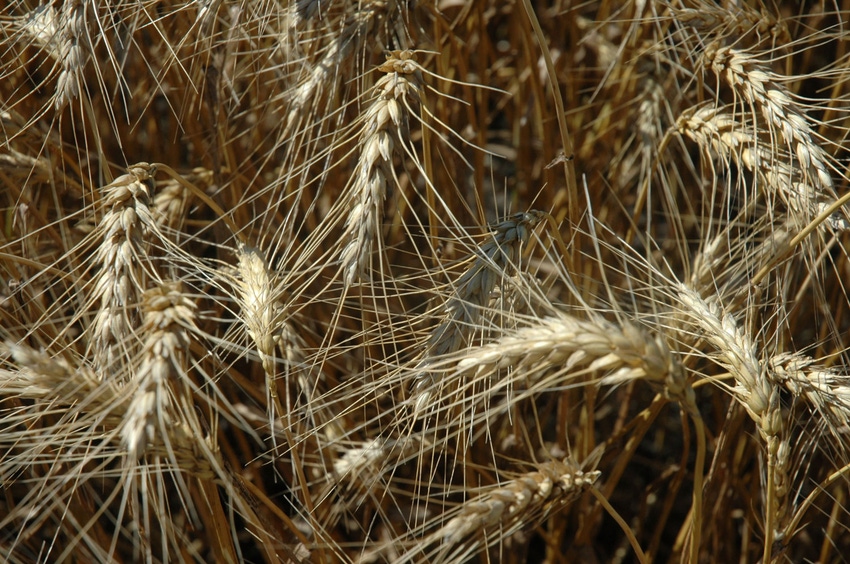November 8, 2013

At this writing, Oklahoma and Texas Panhandle wheat may be forward contracted for 40 cents less than the 2014 Kansas City (KC) July wheat contract price. The KC July wheat contract price is near $7.10. The forward contract price is $6.70.
USDA’s Crop Progress and Condition report indicates that over 90 percent of the 2014 U.S. winter wheat has been planted. The 2014 wheat crop is in significantly better condition than last year. Only 6 percent of the 2014 wheat is in poor to very poor condition compared to 19 percent last year.
Eighty-nine percent of the 6 percent of the U.S. winter wheat rated poor to very poor is hard red winter (HRW) wheat. Of that 89 percent, most (64 percent) is in Texas with Kansas and Oklahoma having the other 34 percent.
Still, planted wheat in Kansas, Oklahoma, and Texas is in much better condition than last year’s wheat. Twenty percent of the Texas wheat is rated poor to very poor with 41 percent rated good to excellent. At this same time in 2012, the Texas wheat crop was rated 24 percent poor to very poor and 34 percent good to very good.
Oklahoma’s 2014 planted wheat is rated 4 percent poor to very poor compared to 30 percent last year. Seventy-one percent of Oklahoma’s wheat is rated good to excellent compared to 21 percent last year.
Kansas wheat ratings for the 2014 crop are 4 percent poor to very poor and 60 percent good to excellent. At this same time last year, Kansas wheat was rated 10 percent poor to very poor and 37 percent good to excellent.
The odds are that 2014 U.S. HRW wheat production will be close to one billion bushels compared to the 2013 production of 791 million bushels. Higher HRW wheat production will partially be offset by lower beginning stocks.
If you are enjoying reading this article, please check out Southwest Farm Press Daily and receive the latest news right to your inbox.
HRW wheat ending stocks for 2013/14 are projected to be about 200 million bushels. If 2014 U.S. HRW wheat production is one billion bushels, the total HRW wheat supply for the 2014/15 marketing year would be 1.2 billion bushels.
Total HRW wheat use for the 2012/13 marketing year was 996 million bushels and for the 2013/14 marketing year is projected to be 947 million bushels. The five-year average is 915 million bushels.
With lower expected exports in 2014/15, total HRW wheat use is assumed to be 950 million bushels. This assumption implies that 2014/15 HRW wheat ending stocks would be 250 million bushels. The five-year average is 325 million bushels.
United States 2013/14 marketing year wheat ending stocks are projected to be about 550 million bushels. Assuming 2014 production to be 2.2 billion bushels and with wheat imports at 125 million bushels, total 2014/15 U.S. wheat supplies would be 2.875 billion bushels.
Assuming total 2014/15 wheat use at 2.3 billion bushels, 2014/15 marketing year ending stocks would be 575 million bushel, which is about the same as projected for the 2013/14 wheat marketing year.
At this writing, Oklahoma and Texas Panhandle 2014 wheat may be forward contracted for about $6.70. In early November 2012, wheat could have been forward contracted for 55 cents less than the KC July 2013 contract price or about $8.70.
The difference between November 2012 and November 2013’s expected June harvest prices is that the 2014 U.S. winter wheat crop has been established and is in significantly better condition than the 2013 wheat crop was at this time last year.
Also, 2013/14 corn ending stocks are projected to be about 2 billion bushels compared to the 2012 November WASDE estimate of 650 million bushels.
Higher expected wheat production and a lot more corn are expected to result in a $2 decline in harvest prices.
Similar stories on Southwest Farm Press:
About the Author(s)
You May Also Like






